FearlessSmile
Rough_Rock
- Joined
- Mar 29, 2019
- Messages
- 67
New HCA update is pretty nice! Anyone used it yet?
Yeah definitely, although the diamond I returned a few weeks ago was 34.5 crown, 41.4 pavilion, 61.8 depth with 58% table, think it came just under 5 on HCA score but still showed as average for size (the beta tool) was expecting it to say smaller.I think it should be really useful for illustrating the benefits and trade-offs of the different options - such as 60/60, shallower cuts, high-crown cuts, etc. - and also show how poor cuts look smaller!
Yeah definitely, although the diamond I returned a few weeks ago was 34.5 crown, 41.4 pavilion, 61.8 depth with 58% table, think it came just under 5 on HCA score but still showed as average for size (the beta tool) was expecting it to say smaller.
and also show how poor cuts look smaller!
So please be careful and not assume that a stone that ranks as average, large or small is automatically good or bad in light return. While I would agree that size and light performance correlate with each other to a certain degree, they can also be independent.
After participating here for many years, I can totally understand why people feel like this....but in fact, a well-cut 60/60 used to spread 6.5mm
The GIA EX cut grade put an end to all that- and now carat stones rarely break 6.4mm.
Sellers of "Ideal Cuts' will say such stones appear larger due to girdle to girdle brilliance.....and if we're comparing two 6.3mm stones, that may be true.
But a well cut 60/60 spreading 6.5 will appear larger than a super ideal of 6.3mm.
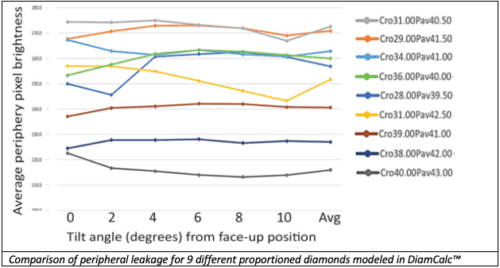
Here is a concise description that should answer your questions (and everyone elses).I am kind of wondering how the tool works with regards to the Looks Like aspect.
Does the tool just take the mean or median of a large sample of stones of a given weight, in order to then base an assessment of an individual size against that mean/median size?
Or does it also include some assessment of likely edge-to-edge brightness (or lack thereof), perhaps using the GIA/AGS ASET image tables for the different crown/pavilion combinations, and then base the Looks Like grade against a SuperIdeal or good 60/60 or the 'best' ASET images?
Or a combination of the two?
Or something completely different??
I appreciate it is a patented tool and such details may well be a proprietary secret, thoughlol
Thanks Garry!Here is a concise description that should answer your questions (and everyone elses).
https://www.pricescope.com/wiki/hca-looks-like-apparent-diamond-size
The algorithm uses mm spread PLUS edge leakage.
Wait! I found some science
The blog has the top level stuff:
https://www.pricescope.com/blog/looks-like-the-new-addition-to-hca
and links through to the science
https://www.pricescope.com/wiki/hca-looks-like-apparent-diamond-size
It's too late in the evening to look at the maths sectionbut I am intrigued by the peripheral brightness measurement at different tilt angles, as shown here:

Just thinking out loud, but if it's possible to measure digital pixel brightness, does that mean it's also possible to measure maximum and minimum brightness? And therefore measure contrast ratios? Not just round the edges but across the whole stone? In order to quantify perceived brightness of the brightest areas and weed out stones that are just sort of dull grey and boring, instead of being full of life?
That is a poor description of what Sergey and Cutwise.com is doing, especially for measuring / estimating / calculating fire as percieved by humans with 2 eyes. But it is way more complex including flash size and duration etc
Or is that exactly what @Serg's work has been doing?
Either way, I think the fact the graph suggests it's possible at tilt angles is really potentially useful - I feel like I bring it up a lot, but for me, ASET limited to head-on only images limits its usefulness in terms of understanding how a stone performs during movement (i.e. in more 'real life' situations), especially for fancies such as stepcuts, which really do need assessment at all angles to ensure they are not a stinker, lol. It is a good idea to use ASET with rotation / tilting especially for fancy shapes because you can not easily predict the variances as you can with rounds. I have a technique to make it stereoscopic.
If analysis and comparison was possible at different angles, not just in terms of ASET performance but also the brightness/contrast performance, that could illustrate/evidence stones that really perform well and aren't just cut for one-angle (face-on) performance and hitting AGS targets, i.e. that are cut to perform well in motion? I never made a video of it, but the test was like this one for very small diamonds where the crown facets and pavilion facets are quite often misaligned. That is the top has been rotated 22.5 degrees by accident when turning the stone over into a dop to polish the other side. (happens often in very small stones cause it is hard to see). So I collected 30 or so of these that had great but different Ideal-scope light return, and put them into a box like this one in this video. The result was that face up the correctly aligned stones looked better - but when tilted by about 10degrees plus the offset stones looked better. So I do not reject them since 90% of the time small stones are not face up (shoulder stones etc).
@diagem mentioned in a recent Instagram posting about how he and/or his team had cut a stone deliberately to perform well in motion (or at angles other than face-on - I can't remember the exact wording now) so although I know he is not a man that lives and dies by measured performance, instead preferring beauty, perhaps an assessment tool that worked at a variety of angles would show his skill?
I don't know... I'm probably over-tired, under-caffeinated, and just letting my train of thought derail slowly in a remote siding far off the actual beaten track...
Just checked my stone and it says "Looks Like size BETA". What does Beta even mean?
"In software development, a beta test is the second phase of software testing in which a sampling of the intended audience tries the product out."Just checked my stone and it says "Looks Like size BETA". What does Beta even mean?
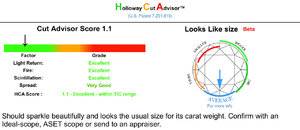
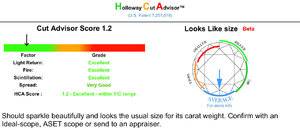
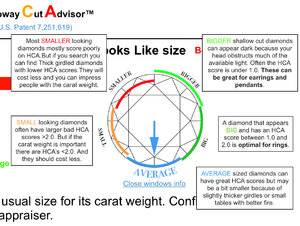
@Rockdiamond hello. I get the spirit of your post. In the interest of fact-checking can you link me to any 1.00 ct RB only spreading 6.3mm yet graded AGS Ideal? Never mind "super ideal". Even generic Ideal should not be possible....After participating here for many years, I can totally understand why people feel like this....but in fact, a well-cut 60/60 used to spread 6.5mm
The GIA EX cut grade put an end to all that- and now carat stones rarely break 6.4mm.
Sellers of "Ideal Cuts' will say such stones appear larger due to girdle to girdle brilliance.....and if we're comparing two 6.3mm stones, that may be true. But a well cut 60/60 spreading 6.5 will appear larger than a super ideal of 6.3mm...
@Garry H (Cut Nut)
Just a small correction
Spread = (D/(6.44))3 – C
To
Spread = (D/(6.44))^3 – C
Looks great. Like the average option. I like the formulae
Fwiw, here's my AGS# from post #2 - the 0.9 vs 1.0 HCA
104097975020
Hi JohnCongrats on the update. I enjoy reading the reactions.
@Rockdiamond hello. I get the spirit of your post. In the interest of fact-checking can you link me to any 1.00 ct RB only spreading 6.3mm yet graded AGS Ideal? Never mind "super ideal". Even generic Ideal should not be possible.
Thank you,
The difference is based on the symmetry. I did not yet announce it, but please to see that folk have noticed.That was perfectly helpful. I believe I know what it is, but I want to make sure.
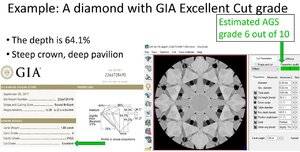
Hi John
I hope you're well and get to stay home for the holidays
Re-reading my post- I never wrote that AGS Ideal cut stones don't break 6.3mm.
A quick search on Rapnet turns up a minuscule sampling of AGS Ideal Cut ( 0 Polish/Symmetry/Cut)
and indeed, all of the 24 stones ( search parameters 1.00ct/AGS/no color/clarity restrictions) broke 6.3mm- ranging from 6.34 to 6.52
The same search for GIA graded stones yields 16638 diamonds- many are smaller than 6.3mm
I don't know that we can find metrics but my gut feeling is that spread on well cut stones was far better on average before the GIA introduced the cut grade.
I think we both agree that adding the "Look Like Size" data on HCA is a big plus.
Hi @the_mother_thing
Would you mind sharing the AGS Cer ID with me? It will help me understand the difference.
If you prefer to keep it private just use the contact us and it should get to me.
Here is a link for your convenience. https://www.pricescope.com/contact
Thank you
The bottom half is too deep at 44%.
DF it is wrong to use %'s. angles are what light performs too.The bottom half is too deep at 44%.. I'd prefer a 1ct at 6.45mm
Aren't most MRB pointed?DF it is wrong to use %'s. angles are what light performs too.
For example is a crown angle is 2 degrees lower than Tolkowsky then 44% is optimal.
And if a stone has a small culet then that can bump your 44% up by 0.2 degrees from 41.3 to 41.5.